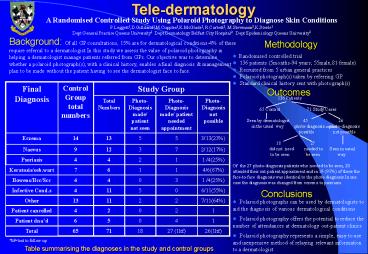Teledermatology - PowerPoint PPT Presentation
1 / 1
Title:
Teledermatology
Description:
Dept General Practice Queens University1 Dept Dermatology Belfast City Hospital2 Dept Epidemiology Queens University3 ... Recruited from 5 urban general practices – PowerPoint PPT presentation
Number of Views:504
Avg rating:3.0/5.0
Title: Teledermatology
1
Tele-dermatology
A Randomised Controlled Study Using Polaroid
Photography to Diagnose Skin Conditions P.Leggett1
,D.Gilliland1,M.Cupples1,K.McGlade1, R.Corbett2,
M.Stevenson3,K.Steele1 Dept General Practice
Queens University1 Dept Dermatology Belfast
City Hospital2 Dept Epidemiology Queens
University3
Background Of all GP consultations, 15 are for
dermatological conditions-4 of these require
referral to a dermatologist.In this study we
assess the value of polaroid photography in
helping a dermatologist manage patients referred
from GPs. Our objective was to determine whether
a polaroid photograph(s), with a clinical
history, enables a final diagnosis management
plan to be made without the patient having to see
the dermatologist face to face.
Methodology
- Randomised controlled trial
- 136 patients (5months-94 years 55male,81
female) - Recruited from 5 urban general practices
- Polaroid photograph(s) taken by referring GP
- Standard clinical history sent with
photograph(s)
Final Diagnosis Control Group total numbers Study Group Study Group Study Group Study Group
Final Diagnosis Control Group total numbers Total Numbers Photo-Diagnosis made/ patient not seen Photo-Diagnosis made/ patient needed appointment Photo-Diagnosis not possible
Eczema 14 13 5 5 3/13(23)
Naevus 9 12 3 7 2/12(17)
Psoriasis 4 4 2 1 1 /4(25)
Keratosis/seb.wart 7 6 1 1 4/6(67)
Bowens/Bcc/Scc 4 4 0 3 1 /4(25)
Infective Cond.s 4 11 5 0 6/11(55)
Other 13 11 2 2 7/11(64)
Patient cancelled 4 2 0 2 1
Patient dnad 6 5 0 4 1
Total 65 71 18 27 (1ltf) 26(1ltf)
Outcomes
136 Patients 65 Control
71 Study Cases
Seen by dermatologist 45
26 in the usual way
photo-diagnosis photo-diagnosis
possible not possible
18
27 did
not need needed to Seen in usual
to be seen
be seen way Of the 27
photo-diagnosis patients who needed to be seen,
20 attended their out-patient appointment and in
19 (95) of these the face-to-face diagnosis was
identical to the photo-diagnosis.In one case the
diagnosis was changed from eczema to psoriasis.
Conclusions
- Polaroid photographs can be used by
dermatologists to aid the diagnosis of various
dermatological conditions - Polaroid photography offers the potential to
reduce the number of attendances at dermatology
out-patient clinics - Polaroid photography represents a simple, easy
to use and inexpensive method of relaying
relevant information to a dermatologist
ltflost to follow up
Table summarising the diagnoses in the study and
control groups































